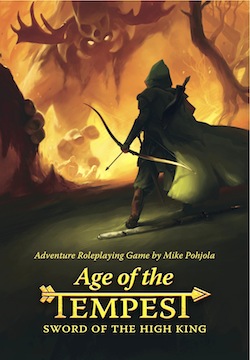 Myrskyn aika rulebook cover | |
| Designers | Mike Pohjola |
|---|---|
| Publishers | Johnny Kniga Kustannus |
| Genres | Fantasy |
Myrskyn aika ("The Time of the Storm") is a Finnish role-playing game.
 Myrskyn aika rulebook cover | |
| Designers | Mike Pohjola |
|---|---|
| Publishers | Johnny Kniga Kustannus |
| Genres | Fantasy |
Myrskyn aika ("The Time of the Storm") is a Finnish role-playing game.
In the late 1990s, Mike Pohjola became interested in various theories of the Nordic style of LARPing (Live Action Roleplaying), how it differed from the American style, and how players could better immerse themselves in character roles. He first created .laitos (.institute) in 1997, a dystopian LARP set in an authoritarian future; and Paljon melua tyhjästä (Much Ado About Nothing) in 1998, a retelling of Shakespeare's play using experimental techniques. [1] The latter was what Pohjola would later call his "least successful experiment". [1]
For his next LARP, he turned to Tolkienesque fantasy, creating a world called Valenor for a LARP he titled Myrskyn aika (Time of the Storm). [2] The LARP was set in a land Pohjola described as "an evil empire", where players would take on the roles of rebels fighting for what they perceived as good. [1] Pohjola used several techniques he had gleaned from his earlier LARP experiments. [1]
After running various iterations of this LARP for several years, Pohjola decided to publish Myrskyn aika as a combination role-playing game/LARP in which a simplified rules system would allow character generation and character interaction to be paramount. The result was a three-book set of rules published by Johnny Kniga Publishing in 2003. [2] Although several magazines and newspapers in the large cities of Turku and Helsinki reviewed the books, and sales in those cities were correspondingly good, almost no media in the rest of Finland took notice. [3]
In 2006, Myrskyn aika's setting of Valenor was used as the basis for the Swedish LARP Dragonbane . [4]
Pohjola continued to produce material for the land of Valenor, including several novels and a mass-funded role-playing game/LARP system, Myrskyn sankarit (Heroes of the Storm) in 2013. [5]
The reviewer for the Helsinki University Roleplaying Club zine Alterations wrote "I don't see anything ground-breaking about the book combining tabletop and live-action role-playing." But the reviewer found "The format is pleasant and suits me well." The reviewer also lauded the fact that all of the content meant for players was about the setting and the characters; rules were not introduced until the section reserved for the gamemaster. [3]
In the Finnish newspaper Turun Sanomat, Markku Soikkelim called Pohjola "a versatile professional writer" and Myrskyn aika "the first of its kind and a milestone for the Finnish role-playing game hobby." Soikkelim found the game to be "a very thorough and clear presentation of the familiar sword & sorcery fantasy world. Even enthusiasts who have consumed dozens of these types of worlds that adhere to the Tolkien standard can find something to read." He also complimented Pohjola for the emphasis on character creation, saying, "Pohjola not only explains how to create a psychologically challenging role figure but also gives opportunities to do so; Valenor is open to many lifestyles and gender roles." However, he also noted the shortcomings of Myrskyn aika: The lack of an index made finding relevant material very difficult; and the absence of any scenarios forced gamemasters to create all aspects of their adventures. [2]

A gamemaster is a person who acts as an organizer, officiant for regarding rules, arbitrator, and moderator for a multiplayer role-playing game. They are more common in co-operative games in which players work together than in competitive games in which players oppose each other. The act performed by a gamemaster is sometimes referred to as "Gamemastering" or simply "GM-ing".

A live action role-playing game (LARP) is a form of role-playing game where the participants physically portray their characters. The players pursue goals within a fictional setting represented by real-world environments while interacting with each other in character. The outcome of player actions may be mediated by game rules or determined by consensus among players. Event arrangers called gamemasters decide the setting and rules to be used and facilitate play.

A role-playing game is a game in which players assume the roles of characters in a fictional setting. Players take responsibility for acting out these roles within a narrative, either through literal acting or through a process of structured decision-making regarding character development. Actions taken within many games succeed or fail according to a formal system of rules and guidelines.
Star Wreck is a series of Finnish Star Trek parody movies started by Samuli Torssonen in 1992. The first movie, simply named Star Wreck, was a simple Star Control-like animation with three ships shooting at each other, but later movies featured CGI-animated characters and, in the latest films, live actors. Often Star Wreck is used to refer to the latest and most popular film Star Wreck: In the Pirkinning.

Kobolds Ate My Baby! is an independently published role-playing game from 9th Level Games, a small-press publisher and designer of humorous role-playing games (RPGs) based in Pennsylvania. The name is a derivative reference to the Azaria Chamberlain disappearance and the famous misquote, "A dingo ate my baby!" The Super Deluxx Edition was still designed by 9th Level Games but is published by Dork Storm Press.

A role-playing game theory is the ludology of role-playing games (RPGs); a study of the topic as a social or artistic phenomenon. RPG theories seek to understand what role-playing games are, how they function, and how the gaming process can be refined in order to improve the experience and produce more useful game products.

Live action role-playing games, known as LARPs, are a form of role-playing game in which live players/actors assume roles as specific characters and play out a scenario in-character. Technically, many childhood games may be thought of as simple LARPs, as they often involve the assumption of character roles. However, the scope of this article concerns itself mainly with LARPing in a technical sense: the organized live-action role-playing games whose origins are closely related to the invention of tabletop role-playing games in America in the 1970s.
Dragonbane was a large international live action roleplaying game (LARP) project. The game itself took place from July 27 to August 4, 2006 in Älvdalen, Sweden, close to the border with Norway. There were 325 players from several countries. While there was little media coverage in other countries, it received the attention of Scandinavian newspapers and gaming publications.

The Great Fire of Turku was a conflagration in the city of Turku in 1827. It is still the largest urban fire in the history of Finland and the Nordic countries. The city had faced several large fires before, including an especially devastating fire in 1681.

Powers & Perils (P&P) is a fantasy role-playing game published by Avalon Hill in 1984. The highly complex game was Avalon Hill's first foray into the role-playing game market, and proved to be a commercial failure.

Mikko "Mike" Pohjola is a Finnish playwright, novelist, and game designer. He is the author of Sinä vuonna 1928, 1827, Maailman hauskin, Myrskyn aika, Star Wreck Roleplaying Game, Tähti, Kadonneet kyyneleet, Ihmisen poika, and Age of the Tempest. He is also the narrative designer and main writer of the Agemonia board game.

Eila Mirjam Pehkonen was a Finnish actress.

Age of the Tempest is a tabletop role-playing game, designed by Mike Pohjola and published by the board game company Tactic. The first part, Heroes of the Storm – Sword of the Great King was published in 2013 and retitled into Age of the Tempest – Sword of the High King in May 2014. Age of the Tempest – Sword of the High King is about forest-dwelling rebels, who fight against the troops of the evil dictator.
Jason Morningstar is an American indie role-playing game designer, publishing mostly through Bully Pulpit Games. Morningstar's games often forgo a game master and are set in situations that quickly take a turn for the worse for the player characters. Grey Ranks, for example, is about doomed child soldiers in the 1944 Warsaw Uprising, and Fiasco is about impulsive crooks pulling heists that are sure to go terribly wrong. With these two games, Morningstar became the only named person to have won the Diana Jones award twice as of 2023. Morningstar also works with academia and industry, consulting on using games for teaching and learning in education, with a focus on health sciences.

Emily Care Boss is an indie roleplaying game designer, theorist and publisher. She was a foundational member of The Forge, an early leader in the indie role-playing game movement and is considered the creator of the American Freeform genre of roleplaying games, which combine indie RPG principles and mechanics with Nordic freeform and American chamber live action role-playing techniques. She has been referred to as the "Dean" of the North American school of structured freeform game design.

Dream Park: The Roleplaying Game is a role-playing game published by R. Talsorian Games in 1992. It was designed by Mike Pondsmith and was based on the 1981 novel Dream Park, which is itself about a live-action role-playing game amusement park. The player characters take on the roles of the players in this holographic game, simultaneously playing both the character and the character's alternate persona.
Fantasy Grounds is a virtual tabletop application, which contains a set of tools to assist players of tabletop role-playing games playing either in person or remotely.

Juho Verneri Pohjola is a Finnish jazz trumpeter and composer.

Fantasy Earth: Basic Rules is a role-playing game published in 1994 by Zody Games.